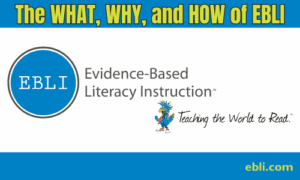Part 2: Accelerate Instruction
As we established in Part 1 of this blog series, English is an alphabetic code. The skills needed to manage this code and the concepts that are unique to the code are covered in Part 1. If you haven’t read it yet, I recommend doing so. You may find it helpful to give you context before delving into the information below.
FOUNDATION FOR GREAT READING –
ACCELERATE INSTRUCTION
Decoding (reading) is utilized to read words and encoding (spelling) is used to spell words. These processes are often taught in a variety of ways, depending on the program or system that is used to teach the code.
Sometimes phonics (matching the sounds we say to the letter(s) that represent them) is taught with explicit instruction in a systematic way and other times it is taught incidentally, thrown in here and there with worksheets and/or when a student is reading and writing. Phonics can be taught print to speech (letters to sounds). In this process, students are shown graphemes or letter(s) and taught what sound or grapheme goes with the letter(s). On the flip side of this, instruction can be speech to print (sounds to letters). This process of instruction requires students to pay attention first to the sounds or phonemes they hear and then, as a second step, to match the letter(s) or graphemes to those sounds.
While teaching the code speech to print (accessing the sounds first, before attaching the letters that spell the sound) is less common, the research has shown this process is more effective and efficient. Instruction that focuses on accessing the sound first (speech) then matching it with the letter(s) that represent the sound (print) is reversible, allowing reading and spelling to be taught simultaneously. Examples of what this looks like in practice is easier to show than tell; it is shared to a degree in the video above and more extensively in the Foundational Reading Instruction webinar!
Below, there are a dozen practices we teach and use as well as why we do them. These practices, based on our experiences and those of the thousands of teachers we train, serve to accelerate student acquisition of the code as well as progress in other areas of reading instruction. Many of these suggestions might be unfamiliar and reading them may feel uncomfortable, especially for educators. Elaboration through hearing them discussed and seeing examples in action rather than reading them on a page can help with integrating the information (so be sure to sign up for the webinar!).

Wondering about the “why” behind these practices? Click Here for a 2-page document with the research-based reasoning behind each practice (also listed below)!
To keep or share the graphic above, you may save it to your device or click here for a PDF version.
1. Teach the sound first, instead of teaching the letter name first.
- We access the sound to read, not the name of the letter.
- You can be an excellent reader and not know any consonant letter names.
- Every consonant letter name is at least 2 sounds.
- ‘b’ = /b/ /ee/
- ‘c’ = /s/ /ee/
- ‘f’ = /e/ /f/
- ‘h’= /ay/ /ch/
- ‘w’= /d/ /u/ /b/ /l/ /y/ /oo/
2. Look at the text, not the pictures, to read the words.
- Looking at pictures when reading takes focus away from the words and almost always leads to guessing/misreading the words.
- Reading is talk written down. The person who wrote the text is communicating with the person who is reading it.
- Text for 3rd grade and older rarely has pictures in it.
3. Read all the sounds in the word, left to right. Do not just read the first sound.
- ALL sounds in a word are important, not just the first sound.
- Many students have received the implication – or are explicitly taught – that the first letter is somehow the only one that really matters.
- This often leads to them guessing the word, inserting a word that starts with that letter but isn’t the word that is written.
4. Sound out unfamiliar words; don’t guess or memorize.
- Rarely is the guessed word the word that is written on the page.
- Misreading words leads to poor comprehension.
- As children move up in grades, there are more words in their reading vocabulary.
- By about 3rd grade, their memory is saturated and their misreading of words increases dramatically.
- Because of this, struggling readers past 3rd grade and into adulthood are typically reading at about a 3rd grade level.
5. Students should track under the words smoothly with their finger rather than tapping.
- Finger gliding under words when reading increases fluency/reading speed.
- Tapping under each word slows down fluency/reading speed.
6. Teach tendencies or patterns instead of rules.
- There are many tendencies in the syllable and sound/spelling patterns in words.
- Some tendencies happen more frequently than others.
- None of the tendencies happen all the time.
- Teaching rules takes significant instructional time.
- Learning and integrating rules requires a huge amount of memory and brain work.
- Many students are confused by inconsistent rules.
7. Interleave (mix, alternate between) instruction as opposed to teaching to mastery.
- Teaching several skills and concepts is preferable to focusing just on one and teaching it to mastery and moving on to something else.
- Teaching explicitly and reviewing and revisiting the skills, concepts, and information previously taught will better lead to mastery over time.
- “It is more effective to distribute practice across different skills than polish each one in turn.” – make it stick: The Science of Successful Learning, pg. 65
- “Interleaving and variation help learners reach beyond memorization to higher levels of conceptual learning and application.” make it stick: The Science of Successful Learning, pg. 65
8. Scaffold writing instruction and correct misspelled words in writing.
- Practicing doing something incorrectly and repeatedly (misspelling), without feedback on how to fix it, results in getting very good at doing it incorrectly.
- It is much more challenging to teach a child to spell correctly once they have repeatedly misspelled words without correction than it is to teach them in the first place.
- “When learners commit errors and are given corrective feedback, the errors are not learned.” make it stick: The Science of Successful Learning, pg. 90
- Meaning: When a child misspells words, show them the correction so they can then spell the words correctly.
9. Teach the correct way to form letters and correct errors in handwriting.
- Learning correct handwriting (top to bottom, left to right) can enhance learning of spelling, vocabulary, and composition skills.
- Handwriting production with verbal prompts (not tracing!) will improve attention, motor skills, muscle memory, and handwriting fluency.
- With EBLI, we use the Peterson Handwriting prompts.
10. Teach the code, as well as blending and segmenting, within the context of words (not in isolation).
- Instruction moves faster.
- When instruction is within words and moves to reading in text and writing, students understand why they are learning what you are teaching them.
- Using words instead of teaching sounds and spellings in isolation makes the instruction meaningful and relevant.
11. Teach speech to print.
- It is more effective and efficient.
- It is reversible, working well for both reading and spelling.
12. Read out loud to students, using a novel that is above the ability level of your highest reader.
- This is important for all students but even more so for emerging and struggling readers.
- This provides all students with exposure to background knowledge, higher level vocabulary, and the sequence and flow of a story.
Some of these suggestions may have felt a bit jarring to you. That’s ok! When solving a problem with the magnitude of moving literacy proficiency from 35% to 95-100% in our country, we must look at doing things differently than we have done them in the past. If we don’t change our actions as educators and parents, we won’t positively change the outcomes for the children we teach and raise.
The most important questions to ask yourself when teaching or supporting a reader or writer, especially if they are not highly proficient in these areas, are these:
- Why am I doing what I’m doing?
- Ideally, the answer should be because it is helping your child or student advance their literacy.
- Is what I’m doing resulting in increased proficiency in reading, spelling, and writing for my student(s) or child(ren)?
- If the answer is no, search out what you need to do differently.
To delve deeper into this topic, I hope you are able to take advantage of the webinar focused on the information in both this blog and Part 1 of the series!
Please comment with your insights, questions, or additional effective, efficient practices that you’ve used when teaching and/or supporting children to become highly proficient in reading, spelling, and writing.





